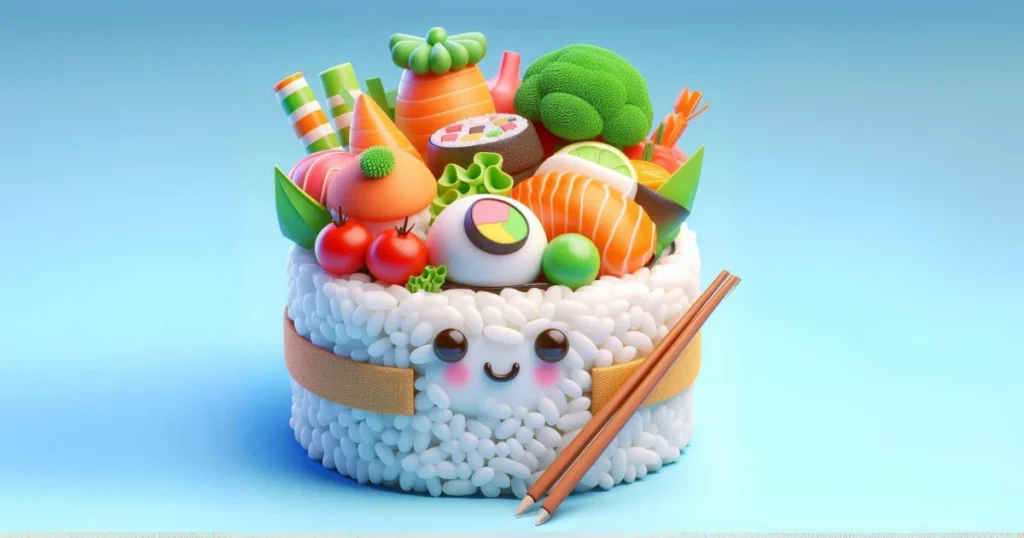
Most people think that sushi is healthy and good for you. However, this well-known Japanese dish frequently contains raw fish. Additionally, people often pair this dish with a salty soy sauce.
This means that some of its chemicals may worry you. This article goes into great depth about sushi and how it can hurt your health.
What is sushi?
Seaweed, cooked rice, vegetables, and either raw or cooked fish make up a sushi roll. People frequently eat it with ginger pickles, soy sauce, and wasabi.
In Japan in the 7th century, sushi first became famous as a way to keep fish fresh. We placed the cleaned fish between rice and salt and left it to develop for a few weeks. When it was ready to eat, it was ready.
Between 1600 and 1700, people added vinegar to rice to expedite the brewing process and improve its flavor. The fermentation process ceased in the 1800s when fresh fish began to replace fermented fish. This resulted in the creation of the first ready-to-eat sushi that you’re familiar with today.
Nutrient-rich ingredients
Many people think of sushi as a healthy food because it has many high-nutrient items.
Fish
You can get a lot of protein, salt, vitamins, and minerals from fish. Apart from that, it’s among the few items that naturally contain vitamin D.
In addition, fish contains omega-3 fats, which are essential for your brain and body to function optimally. These fats assist the body in fighting diseases such as heart disease and stroke.
People who eat fish are also less likely to get some autoimmune diseases, be depressed, and lose their sight or memory as they age.
Wasabi
Sushi frequently comes with wasabi paste. We eat small pieces because the taste is so strong.
To make it, use the chopped stem of Eutrema japonicum. This plant is in the same family as mustard, horseradish, and cabbage.
There are a lot of beta-carotene, glucosinolates, and isothiocyanates in wasabi. According to research, these chemicals may be able to kill germs, reduce inflammation, and fight cancer.
However, due to the scarcity of wasabi plants, many places substitute a fake paste consisting of horseradish, mustard powder, and green dye. It’s not possible that this product will have the same health benefits.
Pickled ginger
You often use gari, which is sweet pickled ginger, to cleanse your tongue in between sushi rolls. Ginger contains good amounts of potassium, magnesium, copper, and manganese.
Besides that, it might have some qualities that help keep bugs and viruses away.
Study after study shows that ginger may help with memory loss, nausea, muscle pain, joint pain, menstrual pain, and even low LDL (bad) cholesterol levels.
Seaweed
Nori, a type of seaweed, is used in sushi rolls. Calcium, magnesium, phosphorus, iron, salt, iodine, thiamine, and vitamins A, C, and E are just some of the nutrients that it has.
Also, 44% of its dry weight is protein, which is about the same as plant foods like soybeans that are high in protein. But one roll of sushi doesn’t have much seafood in it, so it probably won’t help you meet many of your daily nutritional needs.
There may also be chemicals in nori that help fight viruses, inflammation, and even cancer. On the other hand, the amounts of these compounds are likely too small to have any significant health effects.
Low protein and high fat content
People often think of sushi as a meal that can help you lose weight.
However, a lot of sushi uses high-fat tempura batter and sauces, which significantly increases their calorie content.
Also, a single piece of sushi typically only contains a small amount of fish or vegetables. Because of this, it is a low-protein and low-fiber meal that doesn’t do much to curb hunger.
You can eat miso soup, edamame, sashimi, or wakame salad with your next sushi meal to make it full.
Refined carbs and low fiber content
Sushi mostly consists of white rice. Processing has stripped this rice of almost all its fiber, vitamins, and minerals.
Some studies show that eating a lot of processed carbs and having your blood sugar rise because of it may make inflammation worse and raise your risk of diabetes and heart disease.
When making sushi rice, people often add sugar to it. The extra sugar and lack of fiber in sushi cause the carbs to break down in your stomach quickly.
This can cause insulin and blood sugar levels to rise, which may make you eat too much.
However, some studies suggest that the rice vinegar frequently added to sushi may also help lower blood fat, blood sugar, and blood pressure.
If you request brown rice instead of white rice for your sushi, you will receive more fiber and nutrients.
You can also request that your rolls contain more vegetables and less rice to obtain even more nutrients.
Contains a lot of salt.
It is common for sushi to have a lot of salt in it. First, we usually cook the rice with salt. The smoked fish and pickled vegetables also have salt in them.
Last but not least, people frequently eat it with soy sauce, which is highly salted.
If you eat too much salt, you might be more likely to get stomach cancer. People allergic to this ingredient may have higher blood pressure.
If you want to cut down on salt, you should use less or no soy sauce at all and stay away from sushi made with smoked fish like mackerel or salmon.
There is a lot of salt in miso soup, which might help you not eat too much. If you’re trying to cut down on salt, you might want to avoid it too.
Mercury and other toxins
Because of pollution in the oceans, fish may also contain heavy metals like mercury.
Fish that eat other fish, like tuna, swordfish, mackerel, marlin, and shark, tend to have the highest amounts.
Salmon, eel, sea urchin, trout, crab, and octopus are all seafood that are low in mercury.
Toxins found in other fish can also cause ciguatera or scombroid sickness.
Sea bass, grouper, and red snapper are the most likely to lead to ciguatera poisoning, whereas scombroid poisoning is most likely to come from eating tuna, mackerel, or mahi-mahi. Avoid the most polluted fish types to reduce your risk.
Contamination with bacteria and parasites
If you eat sushi made with raw fish, you might get sick from different germs and parasites.
Salmonella, different types of Vibrio bacteria, and Anisakis and Diphyllobothrium parasites are some of the most common species found in sushi.
There are no rules about how to use the “sushi-grade fish” name right now, which is something you should keep in mind. Therefore, this label does not necessarily indicate that the sushi you are consuming is healthy.
Currently, the only requirement is to freeze some fish to eliminate any parasites before consuming them raw.
A recent study examined the raw fish served in 23 Portuguese restaurants and discovered that 64% of the samples contained harmful germs.
But following the right steps when preparing and handling food can lower the risk of contamination.
If you want to avoid getting sick from food, try to eat sushi at well-known places that are more likely to follow good food safety practices. You can also choose rolls with cooked fish or without meat.
Some people, like pregnant women, young children, older adults, and people whose immune systems aren’t strong enough, should stay away from sushi made with raw fish.
How can we maximize the health benefits of sushi?
Follow these easy steps to get the most health benefits from sushi:
- Getting more nutrients is important. Pick brown rice sushi rolls over white rice sushi rolls.
- Temaki, which are cone-shaped hand rolls, have less rice than other types of rolls.
- Boost the amount of protein and fiber in your food. You can eat fish, wakame salad, edamame, or miso soup with your sushi.
- Stay away from rolls that have tempura, cream cheese, or sauces on them. To make it crunchier without these unhealthy things, ask for extra greens.
- Not as much soy sauce. If you can’t handle a lot of salt, don’t use soy sauce or only dip your sushi lightly in it.
- It is safer to buy sushi from places with a good reputation because they are more likely to follow food safety rules.
Is Sushi Healthy?
Sushi can be a healthy meal option, as it often includes nutrient-rich ingredients like fish, which is high in protein and omega-3 fatty acids, as well as vegetables and seaweed, which provide essential vitamins and minerals.
The bottom line
Sushi is a rice, seaweed, vegetable, and seafood roll that can be either raw or cooked in Japan.
It has a lot of vitamins, minerals, and chemicals that are good for your health.
However, some varieties contain high levels of processed carbohydrates, salt, and fats, all of which are detrimental to your health.
Still, sushi can be a healthy part of a well-balanced diet if you watch how you eat it.


